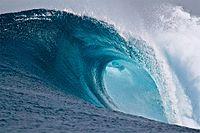
Photo from wikipedia
Abstract The hydrodynamic problem of a breaking wave impacting on a floating body with air bubble effect is modelled based on the incompressible velocity potential theory, which is solved using… Click to show full abstract
Abstract The hydrodynamic problem of a breaking wave impacting on a floating body with air bubble effect is modelled based on the incompressible velocity potential theory, which is solved using the boundary element method in the time domain. To avoid the numerical inaccuracies due to the sharp temporal and spatial variations of velocity and pressure at the initial stage of impact, a dual system is adopted. The simulation close to the impact zone is conducted in a stretched coordinate system, while away from the impact zone the deformation and propagation of incoming overturning wave is simulated in the physical coordinate system. The continuities of both pressure and velocity are enforced at the interface of two zones. When the impact zone is no longer small, the dual systems will be merged and the simulation will be undertaken in one single domain. The air bubble trapped between the breaking wave and the solid surface is taken into account based on the assumption that the trapped air undergoes an adiabatic process. An auxiliary function method is used to decouple the nonlinear mutual dependence of fluid loading, body motion and bubble deformation. Simulations are undertaken for cases related to breaking wave impact in various engineering problems, including a solid coastal wall, a freely floating ship cross section, a floating breakwater and a tension leg platform. Detailed results for pressure, free surface profile, bubble deformation and body motion are provided, and their physical implications are discussed.
Journal Title: Journal of Fluids and Structures
Year Published: 2018
Link to full text (if available)
Share on Social Media: Sign Up to like & get
recommendations!